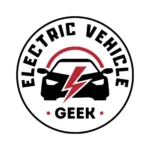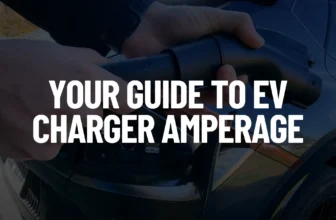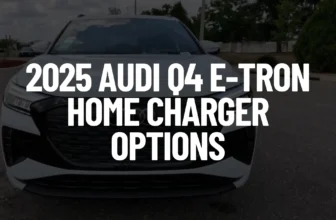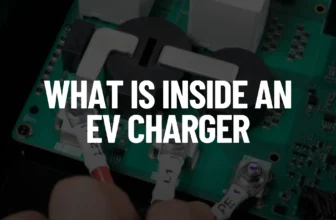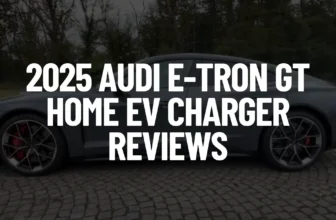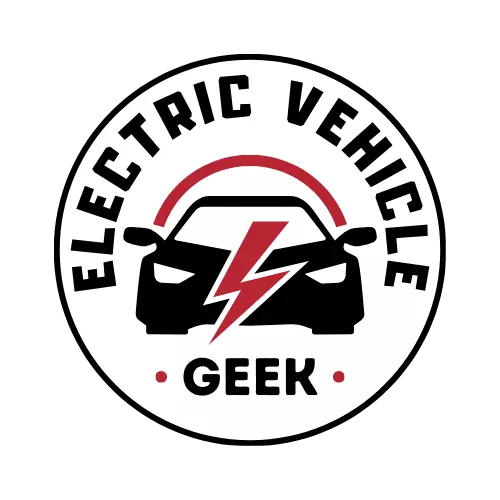One of my favorite electric vehicle (EV) chargers as an EV charger installer and an EV owner is the Enphase IQ 50 EV Charger. I have both the hardwired and the plug-type IQ 50 chargers installed for my geeky activities, such as solar integration on IQ 50 charger and various EV charging tests since I’m an EV charging geek, which you will later learn in this review of the Enphase IQ 50 EV charger.
I’m a typical EV owner, just like you. My daily commute includes short journeys of 20-40 miles per day to and from work, driving my kids to school, and shopping sprees with my family. Normally, I don’t charge my EV every day since I hardly ever reach the limit of my 150 km battery range, but when testing EV chargers, especially a new one, or after adding a feature to my set-up, I charge my EV every day for monitoring purposes.
In this review of the Enphase IQ 50 EV charger, you will learn about my geeky hardwired and plug-type Enphase IQ 50 EV charger charging set-ups and what electric accessories I have added to my set-up, mostly for performance and security features. I will also highlight my independent testing results that will help you determine if the Enphase IQ 50 EV charger is the right EV charger for your driving needs and EV.
Enphase IQ 50 EV Charger Review Summary.
The Enphase IQ 50 EV charger is a Level 2 EV charger that features a J1772 connector and is ideal for vehicles with acceptance rates up to 9.6kW, adding up to 38 miles of range per hour, depending on your EV or plug-in hybrid. It comes in two versions: hardwired and plug-type.
Technical Features
Here’s a summary of the technical features:
- Amperage (amp) Ratings: 32A, 40A, 48A, 64A (Higher amperage generally translates to faster charging; however, it’s essential to choose an amperage compatible with your electric vehicle, and the electrical circuit is crucial)
- Output Cable: 25 ft, pre-wired with J1772 connector
- Dimensions: 19.7″ x 8.9″ x 5.3″
- Weight: 13.5 lbs
- Operating Temperature: -22°F to 122°F (-30°C to 50°C)
- Warranty: 5-year limited warranty and 24/7 customer support
Key differences between hardwired and plug-type versions
The Enphase IQ 50 has two variants:
- IQ 50 (Hardwired): This version requires professional installation and comes pre-wired with a 3-foot cable that connects to the mains through a junction box.
- IQ 50 (Plug-in, NEMA 14-50): This version plugs into an existing outlet and comes with a pre-wired 25-foot cable with the plug attached.
Both variants have built-in Wi-Fi for connection to the Enphase app and integration with the Enphase Energy System for additional smart EV charging features like:
- Energy load management: Optimize charging using solar energy when available.
- Custom scheduling: Schedule charging to take advantage of off-peak electricity rates.
- Remote monitoring and control: Monitor the charging status and control the charger remotely through the app.
Enphase IQ 50 EV Charger First Impressions
The Enphase IQ 50 EV charger physically looks similar to its predecessors, the ClipperCreek’s HCS-50 and the Enphase HCS-D50 EV charger; despite the Enphase IQ 50 EV charger being one of the modern smart EV chargers with smart features, it looks outdated, and the physical design is easily compared with the older versions, and you can’t tell it a smart EV charger due to the similarity in the front panel design and lack of advanced smart panel features.
However, the build looks rugged and durable, just like its predecessors. The Enphase IQ 50 EV charger is built to withstand demanding environments, both residential and commercial; integrated cable wrap and a wall-mount holster add to the convenience and practicality of the Enphase IQ 50 EV charger. The inclusion of a 3-year warranty provides further assurance of quality and reliability.
The Enphase IQ 50 EV charger features a rubber finish connector that offers a superior grip and contributes to overall durability since the rubber finish helps the connectors resist wear and tear compared to bare plastic connectors, contributing to safe and more reliable charging in various conditions.
The charger packaging includes a connector holster that protects the connector from the elements, improves organization, and enhances safety. The connector holster also improves your EV charging cable management, improving the aesthetics of your charging area.
We emphasize the importance of the connector holster in cable management and connector protection since both connector and cables are one of the weak points of an EV charger, as shown in the chart below.
Talking of the EV charger cable, the Enphase IQ 50 EV charger 25ft rugged cable is quite thin compared to its competitors; while the thin Enphase IQ 50 EV charger cable might offer advantages in terms of EV charger cable pliability, these benefits come at the cost of the cable being prone to physical damage from wear and tear, cuts or accidental snags.
Enphase IQ 50 EV Charger Installation & Safety
The Enphase IQ 50 EV Charger packaging includes a user manual with detailed instructions and safety guidelines that we found useful. Proper installation and safety precautions are crucial for optimal EV charger performance and minimizing risks.
Due to its complexity and potential safety risks, professional installation is highly recommended for the Enphase IQ 50 hardwired charger. For the plug-in version, a DIY approach can be considered only if you’re confident with electrical work and meet the pre-requisite conditions for safe installation. Always prioritize safety and consider professional help when unsure.
Luckily for you, we bought and installed both the Enphase IQ 50 EV Charger hardwired and plug-in chargers, and below, we will highlight our wiring diagram and the electrical components we used.
Enphase IQ 50 EV Charger Professional Installation (Hardwired Only)
This option is only suitable for the Enphase IQ 50 plug-in version (NEMA 14-50) and requires electrical knowledge and comfort working with electricity.
Here is our Enphase IQ 50 EV Charger Hardwired Single Phase Wiring Schematic, detailing the direct connection of the Enphase IQ 50 EV Charger to the electrical panel using wires instead of a plug. This schematic illustrates the specific wiring configuration, including the connections, conductors, and components involved in the power supply to the charger.
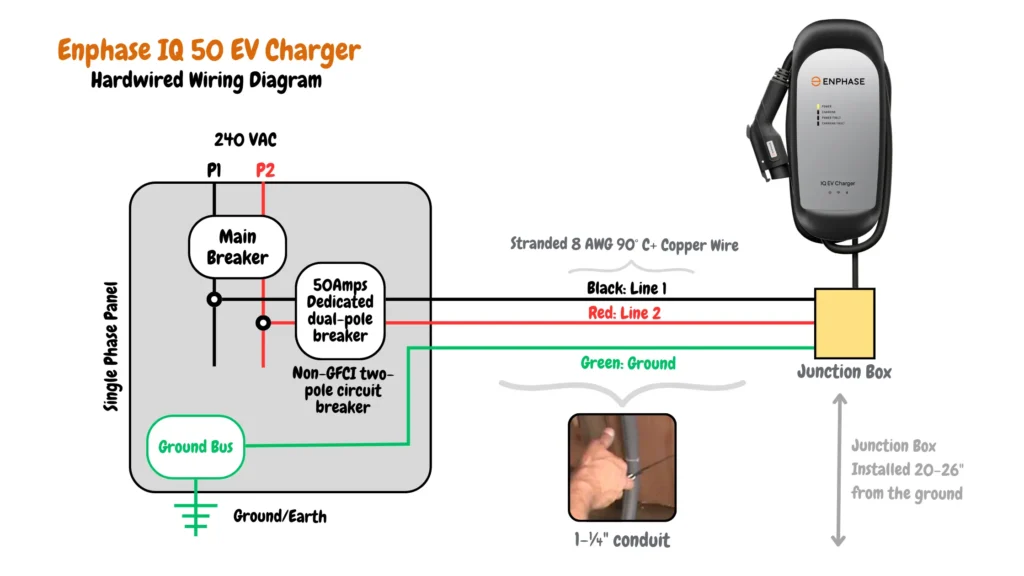
For three-phase electrical panels, use four-prong copper wires, as illustrated in the Enphase Plug-in wiring diagram below:
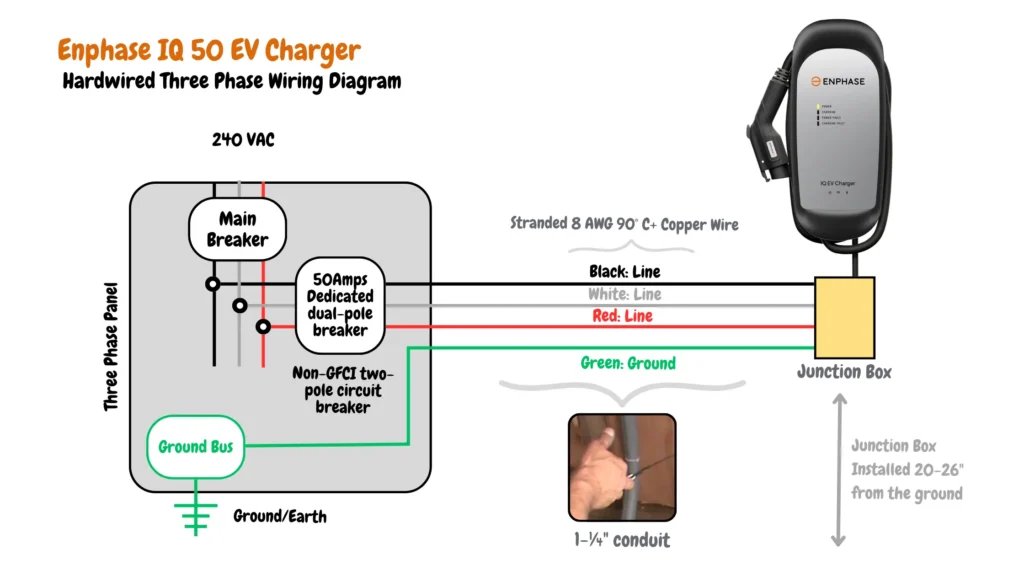
Components of our Enphase IQ 50 EV Charger Hardwired Installation.
The first thing you will need is to access your home electrical panel and determine if it will be able to accommodate all the electrical components you will need for your hardwired installations.
In our case, our single-phase panel (common in most residential settings.) was a sleeping dragon and had no space for additional electrical components we required to install, we decided to use a sub-panel to accommodate additional components such as the dedicated dual-pole breaker, and safety components such as residual current devices (RCD) and surge protection device (SPD).
As you can see in the schematic above, the electrical wires come from the main breaker, into a 50-amp dedicated dual pole breaker.
We used the SIEMENS Q250 50-Amp Double Pole Type QP Circuit Breaker, this breaker provides 50 amps of power required by the Enphase IQ 50 EV Charger. Having a dedicated breaker ensures your charger has its circuit and doesn’t overload other circuits in your home.
Our Hardwired Enphase IQ 50 EV Charger Connection.
The next step involves grounding the EV charger, as you can see from the wiring diagram above, our grounding is connected to the service entry point or the grounding bus, which is usually the main breaker panel. This ensures proper grounding for the entire system, including the Enphase IQ 50 EV Charger.
Regardless of the Neutral connection method, a separate grounding wire (green for the Enphase IQ 50 EV charger as shown in the Enphase IQ 50 EV charger hardwired wiring diagram) must be included in the wiring from the main panel to the Enphase IQ 50 EV Charger. This wire connects to the green ground wire on the Enphase IQ 50 EV Charger and ultimately to the ground bar in the main panel.
We then proceeded to connect the red and black wire to the junction box where we will install the Enphase IQ 50 EV Charger we used a 1-1/4 inch conduit to protect the wires from the main panel or sub-panel to the junction box as shown in our Enphase IQ 50 EV charger hardwired wiring diagram.
Included in the packaging box of the Enphase IQ 50 EV Charger is a ½” trade size watertight conduit fitting and sealing washer that is supposed to seal the junction box and the conduit to provide a moisture-resistant seal in the ⅞” diameter hole of the junction box. (if your junction box is outdoor, you will need a silicon sealant to ensure the ⅞” diameter hole of the junction box is properly sealed.
The Enphase IQ 50 EV Charger comes with three-stranded 8 AWG, 90ºC copper wire that you will need to connect from the wires coming from the main panel or subpanel to the junction box, the wires are marked green for ground, black for Line 1, and Red for Line 2.
After completing the hardwired Enphase IQ 50 EV charger installation, ensure proper cable routing and connection. The green grounding wire from the charger must be securely connected to the grounding busbar in the main or sub-panel for electrical safety.
Additionally, the red conductor connects to the Line 1 terminal, while the black conductor connects to the Line 2 terminal, both on the dedicated breaker within the main or sub-panel.
Always refer to the provided Enphase IQ 50 EV Charger Hardwired Wiring Diagram for specific terminal locations and color coding to guarantee an accurate and safe installation.
If you have any doubts or lack expertise, remember that electrical work can be dangerous, so consulting with a qualified electrician is crucial to ensure your EV charger adheres to local codes and is installed safely.
Added Safety Features of our Hardwired Enphase IQ 50 EV Charger Setup.
While the Enphase IQ 50 EV charger includes some level of built-in surge protection, we installed a Surge Protection Device (SPD) in conjunction with your EV charger installation as shown in the Surge Protection Device (SPD) on our Hardwired Enphase IQ 50 EV Charger Schematic below:
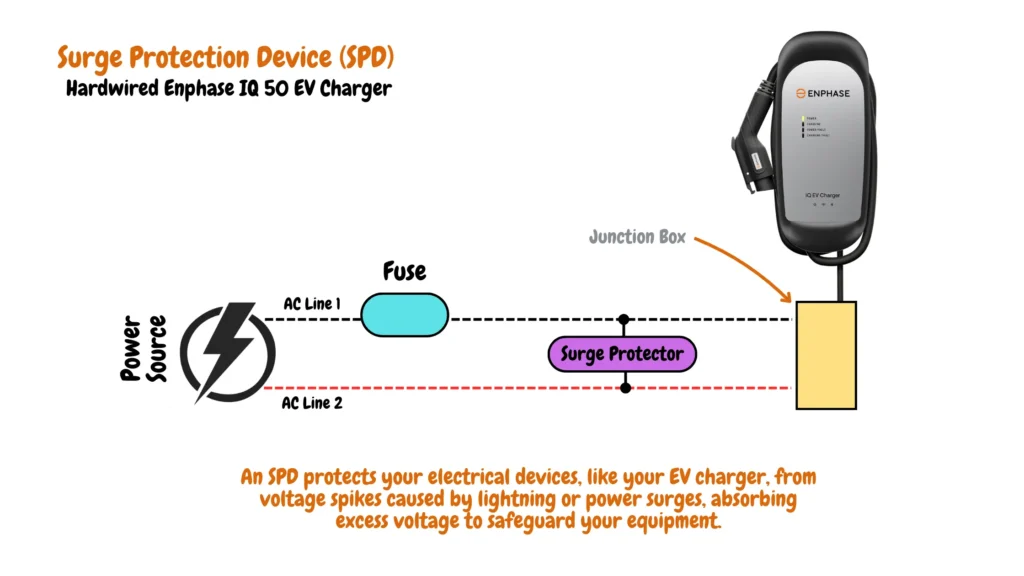
We installed the Eaton Surge Protector to provide enhanced protection for our Hardwired Enphase IQ 50 EV Charger setup, this process took us 30 minutes to install the surge protector to our Enphase IQ 50 EV Charger hardwire installation.
Surge Protection Device (SPD) offers an additional layer of defense against transient voltage spikes caused by lightning strikes, power grid fluctuations, or other external factors, which could otherwise damage the delicate electronics within the Enphase IQ 50 EV Charger and pose safety risks.
This added safeguard gives peace of mind, especially in areas prone to thunderstorms or frequent power fluctuations, ensuring the longevity and reliability of your valuable Enphase IQ 50 EV Charger.
Enphase IQ 50 EV Charger DIY Installation (Plug-in Only)
The Enphase IQ 50 EV charger offers a convenient plug-in option for those who already have a compatible outlet installed. If you’re comfortable with basic electrical tasks and possess the necessary tools and knowledge, you can potentially tackle the DIY installation of this plug-in charger. However, it’s crucial to prioritize safety and adhere to all local electrical codes.
Here is our Plug-in Enphase IQ 50 EV Charger Single-Phase Wiring Schematic:
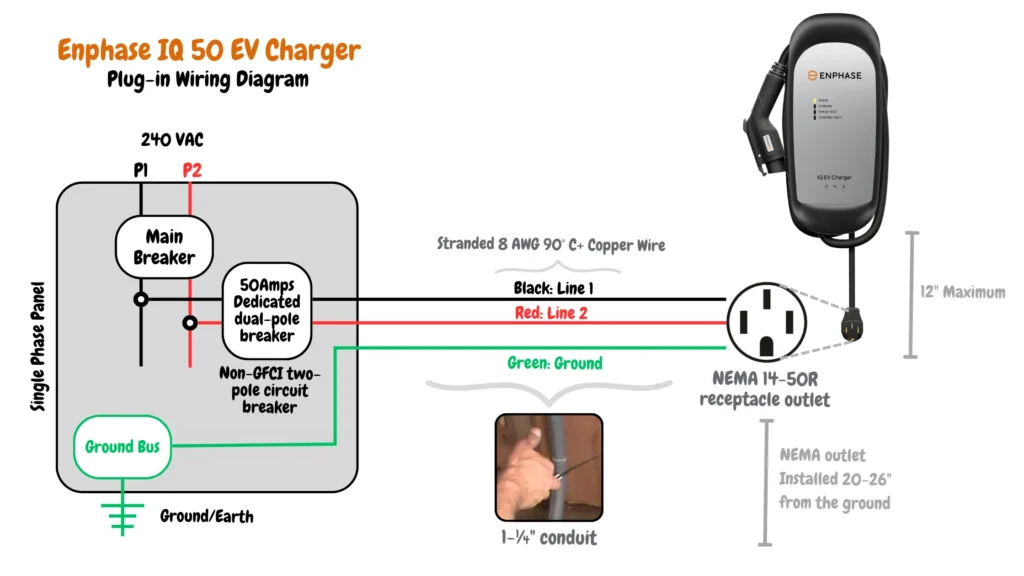
For three-phase electrical panels, you will need four-prong copper wires as shown in the Enphase Plug-in wiring three-phase diagram below:
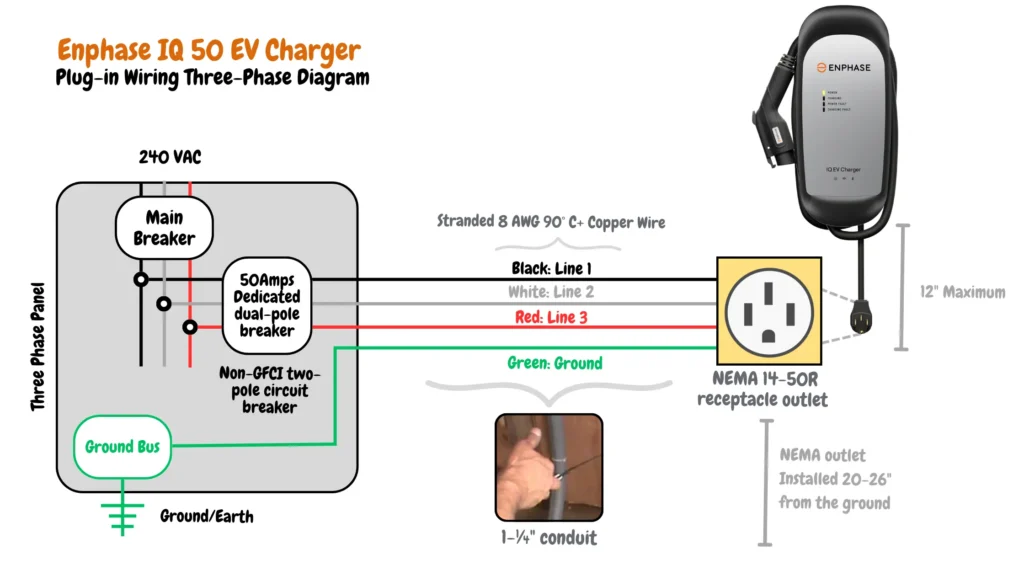
Components of our Enphase IQ 50 EV Charger Plug-in Installation.
In our electrical setup, we operate on a single-phase system, a common configuration found in residential homes. our plug-in Enphase IQ 50 EV charger wiring diagram revolves around a main electrical panel, which hosts the main breaker responsible for controlling the entire electrical network within the household.
For our plug-in Enphase IQ 50 EV charger setup, we’ve added the SIEMENS Q250 50-Amp double pole type QP circuit breaker to our dedicated EV charger circuit.
This breaker serves as a dedicated safeguard, ensuring that our charging system receives a consistent and reliable power supply without overloading other circuits. With its dual-pole design and 50-amp capacity, this breaker effectively protects our EV charger and contributes to the overall safety and efficiency of our electrical setup.
Within the main electrical panel, the ground bus serves as a pivotal component, acting as the central point for all grounding wires in our system. This grounding mechanism plays a crucial role in maintaining electrical safety and ensuring the proper functioning of our EV charging setup.
Our Plug-in Enphase IQ 50 EV Charger Connection.
To ensure correct installation, we’ve referenced the provided wiring diagram of our Enphase IQ 50 EV charger plug-in installation specifically tailored for plug-in setups, which details the appropriate connections for our system.
As part of our plug-in Enphase IQ 50 EV charger setup, we’ve installed a NEMA 14-50R receptacle outlet in a strategic location. we’ve integrated the Leviton 279-S00 50 Amp, 125/250V NEMA 14-50R receptacle. This receptacle, designed for flush mounting, boasts a robust industrial-grade construction suitable for high-power applications like our Enphase IQ 50 EV charger setup.
In adherence to safety standards, the NEMA outlet is positioned between 20-26 inches from the ground, aligning with recommended height guidelines for accessibility and safety. We also oriented the NEMA 14-50P receptacle with the ground socket being at the lowest point as shown in our plug-in Enphase IQ 50 EV charger wiring diagram above.
Additionally, we’ve maintained a maximum distance of 12 inches between the outlet and the EV charger. This proximity ensures a manageable cable length, minimizing potential hazards and optimizing convenience during charging sessions. By following these specifications and guidelines, we ensure a safe and efficient setup for our Enphase IQ 50 EV charger, enhancing both user experience and electrical safety.
Added Safety Features of our Plug-in Enphase IQ 50 EV Charger Setup.
The IQ 50 is likely equipped with GFCI protection, a standard safety feature in EV chargers. It detects imbalances in electrical current and quickly cuts power to prevent shock hazards, and this is the reason we decided not to install residual current devices (RCD), however, we decided to add a surge protection device (SPD) to our plug-in Enphase IQ 50 EV charger set-up as shown in our surge protection device (SPD) of our plug-in Enphase IQ 50 EV charger schematic below:
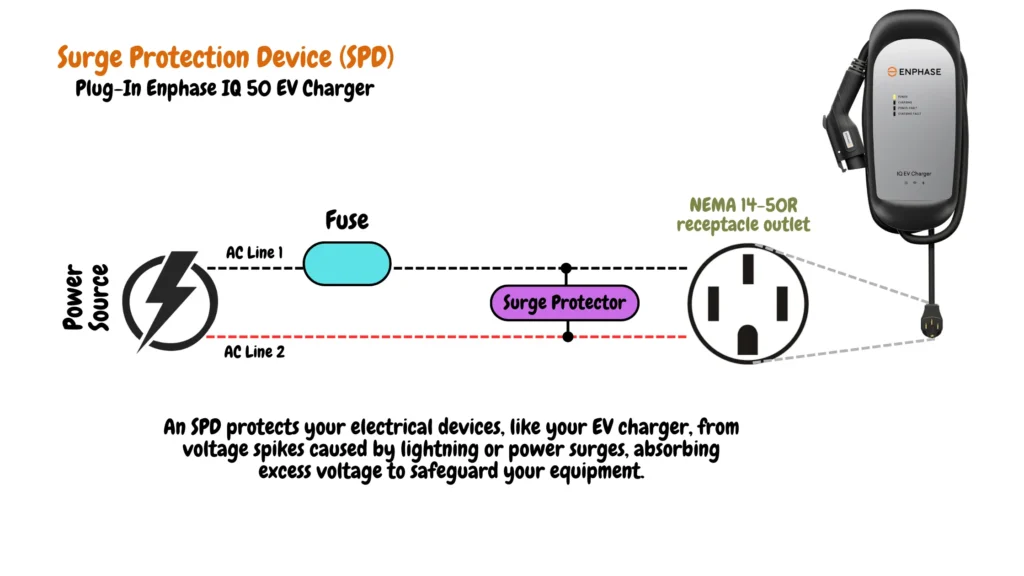
As we earlier stated our main panel had no room for additional electrical components such as a surge protection device (SPD), which could have been the best place to place the device for comprehensive protection of our entire electrical system, including the EV charger. since we added a sub-panel for the plug-in Enphase IQ 50 EV charger setup, we installed the SPD at the point of use (sub-panel), which is directly connected to the plug-in Enphase IQ 50 EV charger, for enhanced safeguard against surges specifically targeting the charger.
We installed the Eaton Surge Protector (pictured above) to offer added protection, shielding the charger from sudden voltage fluctuations. This helps prevent expensive repairs or replacements. The Eaton Surge Protector guards our plug-in Enphase IQ 50 EV charger setup against:
- Lightning strikes: These can cause high voltage surges on the power lines, potentially harming the charger’s electronics.
- Power grid switching: Operations like switching on the power grid can lead to voltage spikes and dips, which may damage the charger.
- Faulty appliances: Short circuits or malfunctions in other appliances on the same circuit can produce transient voltage spikes that pose a risk to the EV charger.
Mounting the Enphase IQ 50 EV Charger.
We successfully mounted the Enphase IQ 50 EV charger on a concrete wall in around 30 minutes.
We chose a convenient spot on the concrete wall for our electric vehicle parking, close to the NEMA 14-50 outlet. After drilling suitable holes, we added plastic angle washers behind them to ensure a snug and flush fit against the wall. Using screws and washers for added stability, we securely attached the EV charger to the wall.
Enphase IQ 50 EV Charger Charging Performance
The Enphase IQ 50 EV charger is a Level 2 charger, capable of charging most electric vehicles (EVs) at speeds of up to 9.6 kW. It uses the J1772 connector standard, making it universally compatible with EVs across North America. Before buying, it’s essential to verify your EV model’s compatibility and supported charging level to guarantee optimal performance.
The IQ 50 boasts a maximum charging power of 9.6 kW, potentially adding up to 38 miles of range per hour, depending on the EV’s battery capacity and limitations. We tested the Enphase IQ 50 EV charger on various electric vehicle models, including testing it on a Tesla, using a Lectron J1772 to Tesla Charging Adapter, we can attest that user experiences will vary depending on factors like car model, battery health, and weather conditions.
However, real-world charging speeds of the Enphase IQ 50 EV charger typically range between 25-35 miles per hour, which is still significantly faster than a standard Level 1 charger for EV owners worried about their electric vehicle range and charging anxiety.
During our test charging session, we charged a BMW i4 to 80% battery level in 8.0 hours. This added 56 kWh of energy, providing an estimated driving range of 230.4 miles. The charging cost was $17.05, which translates to a cost of 7.4 cents per mile.
In a similar charging session, our Jeep Avenger took 6.2 hours to reach 80% battery level, adding 43 kWh of energy and providing an estimated driving range of 199.2 miles. The charging cost was $12.35, translating to a cost of 6.2 cents per mile.
We also tested our Enphase IQ 50 EV Charger setup on a Ford Mustang Mach-E which took 8.7 hours to reach 80% battery level, adding 61 kWh of energy and providing an estimated driving range of 218.4 miles. The charging cost would be $18.56, translating to a cost of 8.5 cents per mile.
Lastly, we used a Lectron J1772 to Tesla charging adapter to test our Enphase IQ 50 EV charger on our Tesla Model Y, and it took the Enphase IQ 50 EV charger 8.9 hours to reach 80% battery level in a similar charging session. The charging session added 62 kWh of energy, providing an estimated driving range of 264.8 miles at $19.07, translating to a cost of 7.2 cents per mile.
Cost Saving with the Enphase IQ 50 EV Charger
We used the Enphase IQ 50 EV charger smart scheduling features to charge our EV during off-peak hours, when electricity rates are significantly lower (25-50% lower on average), which leads to substantial cost savings on our electricity bill. Our schedule for EV charging typically looks like this:
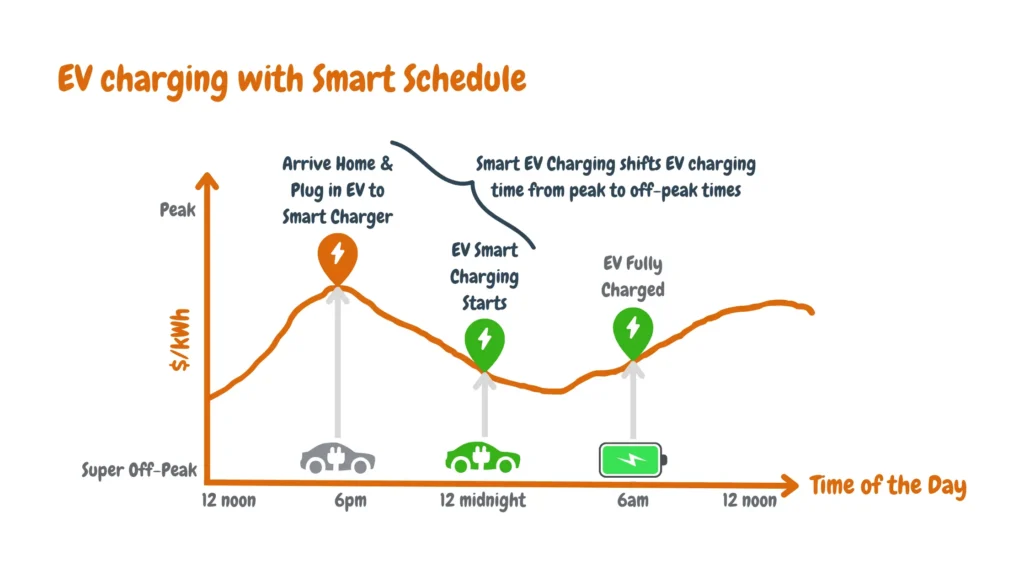
As you can see from our EV charging with the smart schedule infographics above, scheduling our EV charging for off-peak hours, often overnight, can be convenient as it happens while you’re not actively using the electric vehicle. By shifting EV charging to off-peak periods, we spread out the electrical load improving our area grid stability, thereby minimizing the risk of outages for everyone. Charging your EV during these periods can indirectly contribute to a cleaner energy mix especially if your electricity sources include the integration of renewable energy into the grid.
We tested the Enphase IQ 50 EV charger for two weeks, and recorded its speed of charge using smart scheduling, here are the results, including an extended use of our EV over the weekend:
Living With The Enphase IQ 50 EV Charger
The Enphase IQ 50 EV charger is a tough charger that fits the outdoors perfectly, measuring approximately 12 inches wide, 9 inches tall, and 4 inches deep. It has a rectangular shape with rounded corners for a sleek look that also comes in handy when it’s snowy, the curves have less resistance and allow the snow to fall off the outdoor Enphase IQ 50 EV charger
The Enphase IQ 50 EV charger housing is constructed from durable, UV-resistant plastic designed for both indoor and outdoor use, one thing about plastic is that they are poor thermal manager compared to metal housing, this means you will find Level 2 EV chargers such as the Grizzle-E EV charger better for those looking for a good thermal managing Level 2 EV charger. The J1772 connector is also built to withstand harsh weather conditions.
The charger comes with a 25-foot cable that can be wrapped around integrated hooks on the unit for easy cable management and storage. This helps keep the charging area tidy and prevents tripping hazards.
Although the Enphase IQ 50 EV charger lacks more physical monitoring features and buttons, they haven’t been updated since ClipperCreek’s HCS-50 which was launched in 2015, the charger has similar old easy-to-understand LED lights that indicate power status, charging status, power faults, charging faults, and Wi-Fi connectivity. However, for users looking for more advanced monitoring and control features the Enphase IQ 50 EV Charger offers an App that takes monitoring and control to another level never seen before in previous models such as the ClipperCreek’s HCS-50 and the Enphase HCS-D50 EV charger.
We used the Enphase app to effectively monitor and control the Enphase IQ 50 EV charger. With this app, we gained instant insights into our Enphase IQ 50 EV charger’s current performance, including energy production, consumption, and battery status (if applicable). We were able to track our energy consumption in real-time and across various periods such as day, week, month, and year.

As you can see from the Enphase App screenshot above, the app offers more than just basic monitoring capabilities. It enables users to generate reports on energy data and presents it with clear and informative graphs and infographics for easy visualization. Moreover, it provides the convenience of accessing system information and managing settings remotely. Users can receive alerts for any issues and personalize their app experience according to their preferences.
You can easily download the Enphase app on your iPhone or Android smartphone via the App Store or Google Play Store. The smartphone apps are regularly updated, and you can view their release notes on the Enphase App release notes page.
Based on its design and the materials used, the Enphase IQ 50 EV charger appears to be well-built and durable. The NEMA 4-rated enclosure protects the internal components from dust, water, and corrosion, making it a suitable EV charger for both indoor and outdoor use.
The Enphase HCS-D50 EV charger UL 2594 safety certification by ET shows the EV charger meets the safety standards outlined by Underwriters Laboratories (UL) and has been tested by ETL Intertek, an independent testing laboratory.
We compared different EV charger warranties before purchasing the Enphase IQ 50 EV Charger, and the Enphase IQ 50 EV charger is backed by a 5-year limited warranty which is longer coverage compared to other Home EV chargers, although in terms of coverage, the Enphase IQ 50 EV Charger ties with the Grizzl-E Smart Level 2 Charger which has also a 5-year term warranty, its important to note that the warranty typically does not cover normal wear and tear, such as cosmetic damage or cable degradation which is a bummer because this are the parts that tend to wear out fast in an EV charger.
Summary.
The Enphase IQ 50 EV Charger stands out as a reliable and efficient Level 2 charger suitable for both residential and commercial use. With its sleek design, durable construction, and smart charging features, it offers convenience and peace of mind to EV owners. While professional installation is recommended for safety, the plug-in option provides flexibility for those with compatible outlets. The inclusion of features like remote monitoring, surge protection, and a 5-year warranty further enhances its appeal. Overall, the Enphase IQ 50 EV Charger delivers on its promise of fast, safe, and reliable charging for electric vehicles.
Frequently Asked Questions.
Should You Connect a Residual Current Device (RCD) to the Enphase IQ 50 EV Charger?
No, it is not recommended to connect a Residual Current Device (RCD) or Ground Fault Circuit Interrupter (GFCI) directly to the Enphase IQ 50 EV Charger. The charger already has built-in Ground Fault Circuit Interrupter (GFCI) protection, rendering an additional RCD unnecessary. Moreover, adding an RCD could lead to nuisance tripping, disrupting the charging process due to inherent ground current leakage in EV chargers.
Usage Timeline

James Ndungu is a certified EV charger installer with over five years of experience in EVSE selection, permitting, and installation. He holds advanced credentials, including certification from the Electric Vehicle Infrastructure Training Program (EVITP) and specialized training in EV charging equipment and installation, as well as diplomas in EV Technology and Engineering Fundamentals of EVs. Since 2021, James has tested dozens of EV chargers and accessories, sharing expert insights into the latest EV charging technologies.
Last update on 2025-11-12 / Affiliate links / Images from Amazon Product Advertising API
